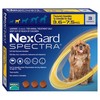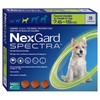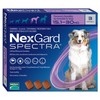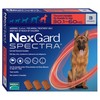Nexgard Spectra
Nexgard Spectra Chewable Tablets are for the treatment of flea and tick infestations in dogs when the concurrent prevention of heartworm disease and/or treatment of gastrointestinal nematode infestations is indicated. They have an efficacy against flea infestations for up to 5 weeks and against tick infestations for up to 4 weeks.
Nexgard Spectra Tablets are presented as mottled red to reddish brown circular (Extra Small Dog) or rectangular shaped chewable tablets.
NexGard Spectra Chewable Tablets for Extra Small Dogs
£17.89Nexgard Spectra Chewable Tablets are indicated for the treatment of flea and tick infestations when prevention of gut worms and/or heartworm disease is also required. Nexgard Spectra kills...[More info]
NexGard Spectra Chewable Tablets for Small Dogs
£18.89Nexgard Spectra Chewable Tablets are indicated for the treatment of flea and tick infestations when prevention of gut worms and/or heartworm disease is also required. Nexgard Spectra kills...[More info]
NexGard Spectra Chewable Tablets for Medium Dogs
£20.99Nexgard Spectra Chewable Tablets are indicated for the treatment of flea and tick infestations when prevention of gut worms and/or heartworm disease is also required. Nexgard Spectra kills...[More info]
NexGard Spectra Chewable Tablets for Large Dogs
£24.84Nexgard Spectra Chewable Tablets are indicated for the treatment of flea and tick infestations when prevention of gut worms and/or heartworm disease is also required. Nexgard Spectra kills...[More info]
NexGard Spectra Chewable Tablets for Extra Large Dogs
£29.39Nexgard Spectra Chewable Tablets are indicated for the treatment of flea and tick infestations when prevention of gut worms and/or heartworm disease is also required. Nexgard Spectra kills...[More info]
Indications for Use
For the treatment of flea and tick infestations in dogs when the concurrent prevention of heartworm disease (Dirofilaria immitis larvae), angiostrongylosis (reduction in level of immature adults (L5) and adults of Angiostrongylus vasorum) and/or treatment of gastrointestinal nematode infestations is indicated.
Treatment of flea infestations (Ctenocephalides felis and C. canis) in dogs for 5 weeks.
Treatment of tick infestations (Dermacentor reticulatus, Ixodes ricinus, Rhipicephalus sanguineus) in dogs for 4 weeks.
Fleas and ticks must attach to the host and commence feeding in order to be exposed to the active substance.
Treatment of infestations with adult gastrointestinal nematodes of the following species: roundworms (Toxocara canis and Toxascaris leonina), hookworms (Ancylostoma caninum, Ancylostoma braziliense and Ancylostoma ceylanicum) and whipworm (Trichuris vulpis).
Treatment of demodicosis (caused by Demodex canis).
Treatment of sarcoptic mange (caused by Sarcoptes scabiei var. canis).
Prevention of heartworm disease (Dirofilaria immitis larvae) with monthly administration.
Prevention of angiostrongylosis (by reduction of the level of infection with immature adult (L5) and adult stages of Angiostrongylus vasorum) with monthly administration.
Contra-indications
Do not use in cases of hypersensitivity to the active substances or to any of the excipients.
Special warnings for each target species
Fleas and ticks need to start feeding on the host to become exposed to afoxolaner; therefore the risk of the transmission of vector-borne diseases cannot be excluded.
Ancylostoma ceylanicum is reported as being endemic only in South-East Asia, China, India, Japan, some Pacific islands, Australia, the Arab Peninsula, South Africa and South America.
Parasite resistance to any particular class of parasiticides may develop following the frequent, repeated use of a product of that class. Therefore, the use of this product should be based on the assessment of each individual case and on local epidemiological information about the current susceptibility of the target species in order to limit the possibility of a future selection for resistance.
Maintenance of the efficacy of macrocyclic lactones is critical for Dirofilaria immitis control. To minimise the risk of resistance selection, it is recommended that dogs should be checked for both circulating antigens and blood microfilariae at the beginning of each season of preventative treatment. Only negative animals should be treated.
Special precautions for use in animals
In the absence of available data, treatment of puppies less than 8 weeks of age and dogs less than 2 kg bodyweight should be based on a benefit-risk assessment by the responsible veterinarian.
In heartworm endemic areas, dogs should be tested for existing heartworm infestation prior to administration of NexGard Spectra. At the discretion of the veterinarian, infested dogs should be treated with an adulticide to remove adult heartworms. NexGard Spectra is not indicated for microfilariae clearance.
The recommended dose should be strictly observed in collies or related breeds.
Special precautions to be taken by the person administering the product to animals
- This product may cause gastrointestinal disturbances if ingested.
- Keep tablets in the blister packs until required, and keep the blisters in the outer carton.
- In case of accidental ingestion, particularly in the case of children, seek medical advice immediately and show the package leaflet or the label to the physician.
- Wash hands after use.
Adverse reactions
In clinical studies, no serious adverse reactions were attributed to the combination of afoxolaner and milbemycin oxime. Adverse reactions such as vomiting, diarrhoea, lethargy, anorexia, and pruritus were uncommonly observed. These occurrences were generally self-limiting and of short duration.
The frequency of adverse reactions is defined using the following convention:
- very common (more than 1 in 10 animals treated displaying adverse reaction(s)).
- common (more than 1 but less than 10 animals in 100 animals treated)
- uncommon (more than 1 but less than 10 animals in 1,000 animals treated)
- rare (more than 1 but less than 10 animals in 10,000 animals treated)
- very rare (less than 1 animal in 10,000 animals treated, including isolated reports).
Use during pregnancy, lactation or lay
Laboratory studies in rats and rabbits have not produced any evidence of teratogenic effects, or any adverse effect on the reproductive capacity in males and females.
The safety of the veterinary medicinal product has not been established during pregnancy and lactation or in breeding dogs. Use only according to the benefit-risk assessment by the responsible veterinarian.
Interactions with other medicinal products and other forms of interaction
Milbemycin oxime is a substrate for P-glycoprotein (P-gp) and therefore could interact with other P-gp substrates (for example, digoxin, doxorubicin) or other macrocyclic lactones. Therefore, concomitant treatment with other P-gp substrates could lead to enhanced toxicity.
Overdose
No adverse reactions were observed in eight-week old healthy puppies after 6 treatments at up to 5 times the maximum dose.
Pharmacodynamic properties
Afoxolaner:
Afoxolaner is an insecticide and acaricide of the isoxazoline family. Afoxolaner acts as an antagonist at ligand-gated chloride channels, in particular those gated by the neurotransmitter gamma-aminobutyric acid (GABA). Isoxazolines, among the chloride channel modulators, bind to a distinct and unique target site within the insect GABACls, thereby blocking pre- and post-synaptic transfer of chloride ions across cell membranes. Prolonged afoxolaner-induced hyperexcitation results in uncontrolled activity of the central nervous system and death of insects and acarines. The selective toxicity of afoxolaner between insects, acarines and mammals may be inferred by the differential sensitivity of the insects and acarines' GABA receptors versus mammalian GABA receptors.
It is active against adult fleas as well as against several tick species such as Rhipicephalus sanguineus, Dermacentor reticulatus and D. variabilis, Ixodes ricinus and I. scapularis, Amblyomma americanum, and Haemaphysalis longicornis.
Afoxolaner kills fleas before egg production and therefore prevents the risk of household contamination. It can be used as part of a treatment strategy for the control of flea allergy dermatitis (FAD).
Milbemycin oxime:
Milbemycin oxime is an antiparasitic endectocide belonging to the group of macrocyclic lactones. Milbemycin oxime contains two major factors, A3 and A4 (ratio of 20:80 for A3:A4). It is a fermentation product of Streptomyces milbemycinicus. Milbemycin oxime acts by disrupting the glutamate neuro-transmission in invertebrates. Milbemycin oxime increases glutamate binding with consequent enhanced chloride ion flow into the cell. This leads to hyperpolarisation of the neuromuscular membrane resulting in paralysis and death of the parasites.
Milbemycin oxime is active against several gastrointestinal worms (Toxocara canis, Toxascaris leonina, Ancylostoma caninum, Ancylostoma braziliense, Ancylostoma ceylanicum, Trichuris vulpis), the adults and immature adults (L5) of lungworm Angiostrongylus vasorum and heartworm (Dirofilaria immitis larvae).
Excipients
Maize starch, Soy protein, Braised beef flavouring, Povidone (E1201), Macrogol 400, Macrogol 4000, Macrogol 15 hydroxystearate, Glycerol (E422), Medium-chain triglycerides, Citric acid monohydrate (E330), Butyl-hydroxytoluene (E321).





